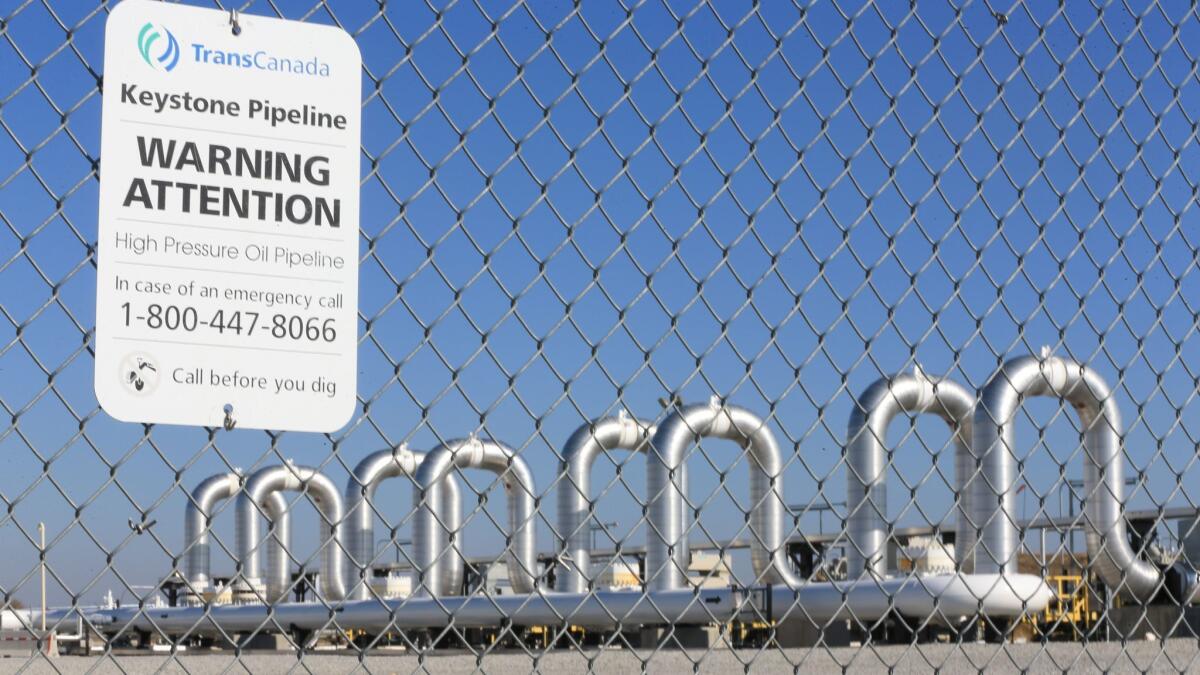Trump signs permit for construction of controversial Keystone XL pipeline

- Share via
President Trump has signed a new order granting permission for the construction of the Keystone XL pipeline, marking the White House’s latest effort to jump-start one of the most controversial infrastructure proposals in recent U.S. history.
The presidential permit signed Friday gives TransCanada, the Calgary-based firm behind the project, permission to “construct, connect, operate and maintain” the pipeline in U.S. territory. The order appears aimed at addressing a ruling from a federal court judge in Montana last fall, who halted the project after finding that the Trump administration had inadequately considered the environmental impacts of the project before allowing it to move forward.
That ruling faulted the State Department for not doing a sufficient review as required under the National Environmental Policy Act. But because that law applies to agency actions, as opposed to those by the White House, the president may be able to sidestep the issue by granting the permit himself rather than delegating the cross-border permit to the secretary of State.
Christopher Guith, acting president of the U.S. Chamber of Commerce Global Energy Institute, praised the decision to grant a new permit.
“We’re pleased to see action that will help clear the way for development of the Keystone XL pipeline,” Guith said in a statement. “The Keystone XL pipeline is one of the most studied pieces of infrastructure in American history.”
However, the move does not address a separate legal hurdle that the project faces in Nebraska, where the state Supreme Court is considering a challenge that landowners have brought against the pipeline route approved by the Nebraska Public Utilities Commission.
Last fall’s federal court decision was a rebuke to Trump, who had vowed to support the pipeline and who signed an executive order days into his presidency restarting the project after the Obama administration had halted it over environmental concerns.
U.S. District Judge Brian Morris, in Montana, issued a 54-page ruling that found that the State Department had “simply discarded prior factual findings related to climate change” from the Obama administration in its zeal to further Trump’s goal of letting the pipeline move forward. In doing so, the administration ran afoul of the Administrative Procedure Act, which requires “reasoned” explanations for government decisions, particularly when they represent reversals of well-studied actions.
“An agency cannot simply disregard contrary or inconvenient factual determinations that it made in the past, any more than it can ignore inconvenient facts” in the present, Morris wrote, citing case law.
The court decision did not permanently block a federal permit for Keystone XL. But it required the administration to conduct a more complete review of potential adverse impacts related to climate change, cultural resources and endangered species, as well as reevaluate the effect of current oil prices on the viability of the pipeline. The court basically ordered a do-over.
At the time, Trump called the ruling “a political decision.”
“I think it’s a disgrace,” he told reporters, adding that the pipeline could generate thousands of jobs. “I approved it; it’s ready to start.”
TransCanada also said at the time that it had no plans to abandon the project. “We have received the judge’s ruling and continue to review it,” company spokesman Terry Cunha said in a statement. “We remain committed to building this important energy infrastructure project.”
“President Trump has been clear that he wants to create jobs and advance U.S. energy security and the Keystone XL pipeline does both of those things,” Russ Girling, TransCanada’s president and chief executive, said in a statement Friday. “We thank President Trump for his leadership and steadfast support to enable the advancement of this critical energy infrastructure project for North America.”
The decade-long saga over the Keystone XL pipeline, which would stretch nearly 1,200 miles from Hardisty, Canada, to Steele City, Neb., has been full of legal twists and turns. Envisioned in 2008 as a way to connect Canada’s oil sands fields with Gulf Coast refineries, the project has died and been resurrected more than once.
Native American tribes and Oklahoma oil magnates have weighed in. Opponents chained themselves to a truck carrying pipe and were arrested. Residents of Nebraska and other states fought the company over land rights. Environmental advocates have objected over concerns about the effects on wildlife.
The Keystone XL (the initials stand for “export limited”), which aims to extend the firm’s existing Keystone pipeline, would transport as much as 830,000 barrels of crude oil per day through a 36-inch pipe. In the United States, the XL pipeline would stretch 875 miles through Montana, South Dakota and Nebraska.
The Obama administration approved the southern leg of the overall pipeline that began operations in January 2014, easing a bottleneck between Cushing, Okla., and refineries on Texas’ Gulf Coast.
The project has met sustained opposition from environmental advocacy groups arguing that it would be especially damaging to the climate because it would mean extracting thick, low-quality oil from Canada’s oil sands, with tree-cutting and energy consumption as part of the process.
In 2015, on the eve of the international climate talks in Paris, the Obama administration announced that it was halting construction on the remainder of the pipeline, arguing that approval would compromise America’s effort to reduce its greenhouse gas emissions. The United States, Obama said, was now a “global leader” in pressing for climate action. “And frankly, approving this project would have undercut that global leadership,” he said.
The decision to deny the pipeline permit came after the completion of a long-awaited final environmental impact statement — 11 volumes of analysis released in 2014.
Brady Dennis and Juliet Eilperin write for the Washington Post.
More to Read
Sign up for Essential California
The most important California stories and recommendations in your inbox every morning.
You may occasionally receive promotional content from the Los Angeles Times.










